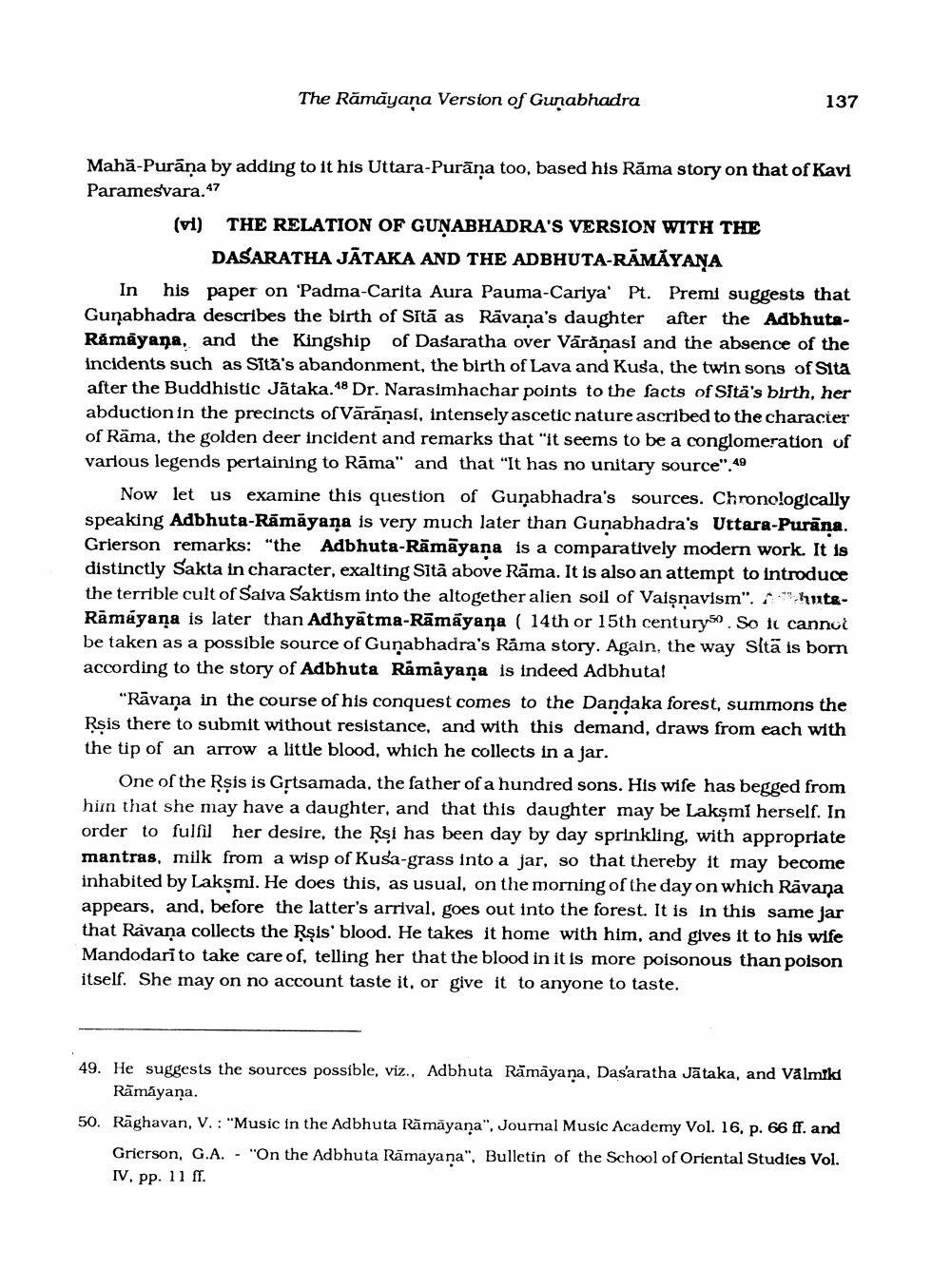________________
The Rāmāyana Version of Gunabhadra
137
Mahă-Purana by adding to it his Uttara-Purāna too, based his Rāma story on that of Kavi Paramesvara. 47
(vl) THE RELATION OF GUŅABHADRA'S VERSION WITH THE
DASARATHA JĀTAKA AND THE ADBHUTA-RAMĂYAŅA In his paper on 'Padma-Carita Aura Pauma-Cariya' Pt. Premi suggests that Gunabhadra describes the birth of Sitā as Rāvana's daughter after the AdbhutaRāmāyaṇa, and the Kingship of Dasaratha over Vārāṇasi and the absence of the Incidents such as Sità's abandonment, the birth of Lava and Kusa, the twin sons of Sita after the Buddhistic Jātaka. 18 Dr. Narasimhachar points to the facts of Sita's birth, her abduction in the precincts of Varanasi, intensely ascetic nature ascribed to the character of Räma, the golden deer incident and remarks that "it seems to be a conglomeration of various legends pertaining to Rāma" and that “It has no unitary source". 49
Now let us examine this question of Guņabhadra's sources. Chronologically speaking Adbhuta-Rāmāyana is very much later than Gunabhadra's Uttara-Purāna. Grierson remarks: "the Adbhuta-Rāmāyana is a comparatively modern work. It is distinctly Sakta in character, exalting Sità above Rāma. It is also an attempt to introduce the terrible cult of Saiva Saktism into the altogether alien soil of Vaişnavism". a u teRāmáyana is later than Adhyātma-Rāmāyaṇa ( 14th or 15th centurys). So it cannot be taken as a possible source of Guņabhadra's Räma story. Again, the way Sita is born according to the story of Adbhuta Ramayana is indeed Adbhuta!
"Rāvana in the course of his conquest comes to the Dandaka forest, summons the Rsis there to submit without resistance, and with this demand, draws from each with the tip of an arrow a little blood, which he collects in a jar.
One of the Rsis is Grtsamada, the father of a hundred sons. His wife has begged from hin that she may have a daughter, and that this daughter may be Lakşmi herself. In order to fulfil her desire, the Rşi has been day by day sprinkling, with appropriate mantras, milk from a wisp of Kusa-grass into a jar, so that thereby it may become inhabited by Lakşmi. He does this, as usual, on the morning of the day on which Rāvana appears, and, before the latter's arrival, goes out into the forest. It is in this same jar that Ravana collects the Rşis' blood. He takes it home with him, and gives it to his wife Mandodari to take care of, telling her that the blood in it is more poisonous than poison itself. She may on no account taste it, or give it to anyone to taste.
49. He suggests the sources possible, viz., Adbhuta Rāmāyana, Dasaratha Jātaka, and Valmiki
Rāmāyana. 50. Rāghavan, V.: "Music in the Adbhuta Rāmāyaņa", Journal Music Academy Vol. 16, p. 66 ff. and
Grierson, G.A. - "On the Adbhuta Ramayana", Bulletin of the School of Oriental Studies Vol. IV. pp. 11 ff.




